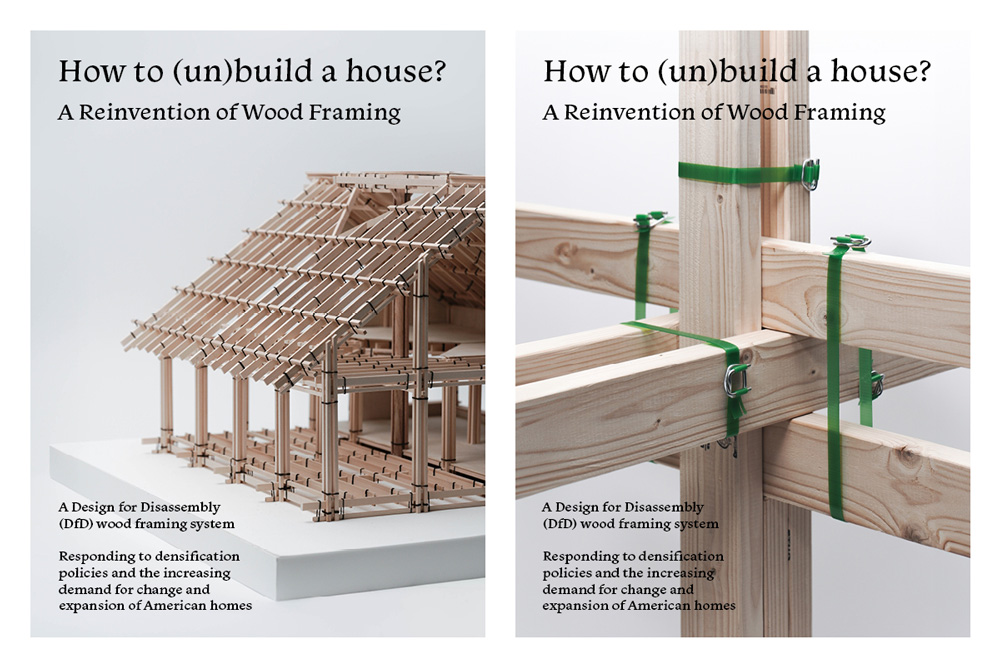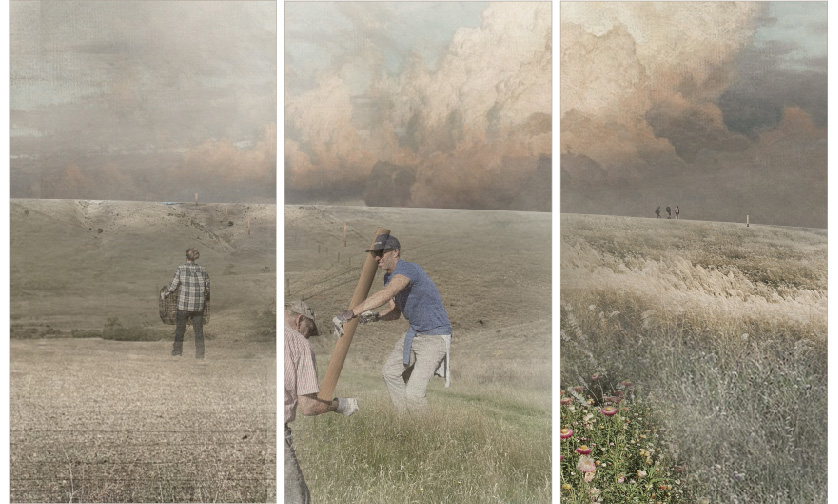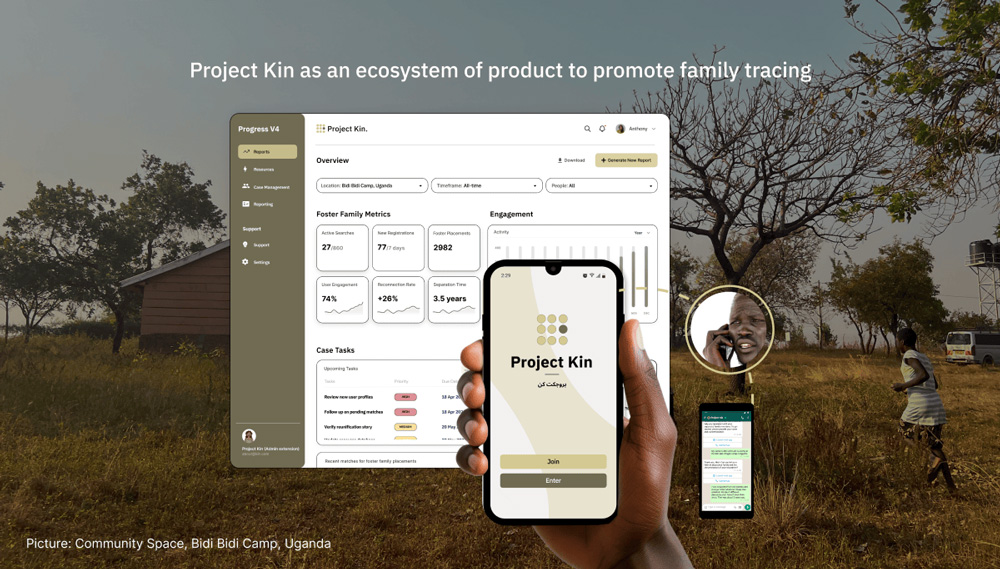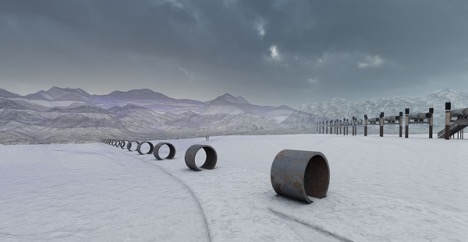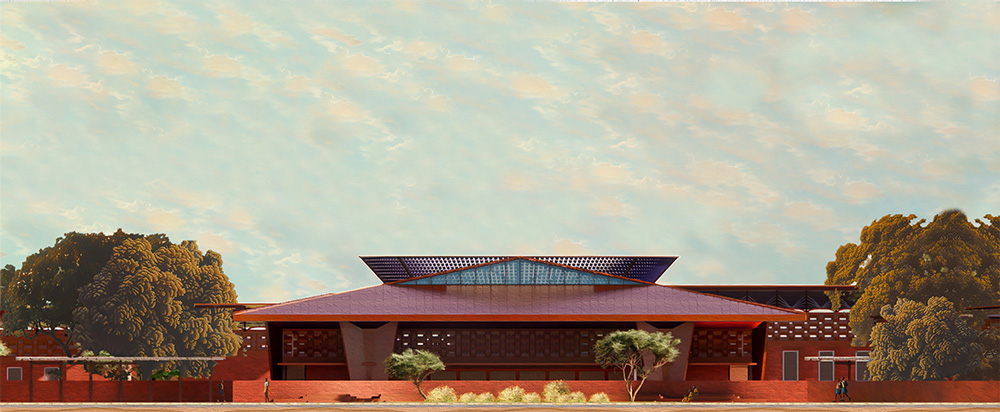How to (Un)build a House? A Reinvention of Wood Framing
Clara Mu He (MArch I ’24)
In recent decades, as we recognize that our extractive practices are driving humanity toward an imminent environmental crisis, there has been a renewed interest in reusing construction materials. Against the backdrop of a national housing crisis, densification policies, and an anticipated surge in residential construction and demolition—compounded by challenges of lumber shortages and sustainability concerns—there is an imperative to rethink how we build and demolish houses.
The predominant method of housing construction in America today is wood framing, which relies heavily on nails and adhesives. This makes materials difficult to reuse and contributes to environmental pollution due to the disposal of wood from demolitions. To divert wood waste from landfills, this thesis proposes a Design for Disassembly (DfD) wood framing system: the Strapped House. Inspired by traditional bamboo construction in Southeast Asia, this system aims to reinvent wood framing by introducing strapping as a non-intrusive means of assembly, facilitating easier disassembly and maintaining material integrity. The approach recognizes the momentum of our current construction industry and leverages the skill sets of local contractors. Instead of centralized prefabrication of panels or modules, the Strapped House system adopts a bottom-up approach, seamlessly integrating into the current labor market of housing construction and empowering local builders to actively participate in sustainable construction and deconstruction.
To demonstrate the application of the Strapped House system, this thesis proposes a three-phased incremental construction on a newly upzoned residential lot in Mattapan, Boston. The proposal illustrates the possibility of building six units on a previously low-density lot, enabling sustainable urban densification.
Seeding Grounds: Working Beyond Arcadia in The Pyrocene
Stewart Crane Sarris (MLA I ’24)
From drought, to fire, Australia’s landscapes face multiple existential threats. A response to the tectonic loss of life in the 2019 ‘Black Summer’ bushfires, Seeding Grounds: Working Beyond Arcadia in the Pyrocene, seeks to reckon with Australia’s perception of country that has engendered its ongoing dance with ecological annihilation. Proposing the establishment of the Fireline National Park along Kangaroo Island’s 2019 ‘Black Summer’ burn scar, the work inverts the methods and means by which land ‘management’ has engendered the disconnect between country and process. Utilising the traditional interventions of the National Park, fence post, rain water water tank, and seed bank, the thesis inverts colonial land management infrastructures in an attempt to cultivate acts of disturbance as a means of growing ecologies forward into uncertain climatic futures. In so doing, Seeding Grounds resists the impulse of a static preservationism, rejecting the preeminent consumption | conservation paradigm in favour of acknowledging that our landscapes are embedded in processes of decay and renewal. Here, the anachronistic mythology of a static ‘Arcadia’ yields to an understanding of country as archival palimpsest, one that envisions a semantic shift from disturbance as destruction to phenomena as process. In this way, Seeding Grounds, brings awareness to Australia’s threatened landscapes, positing that phenomenological processes can perform as a form of generative catharsis through which socio-cultural relationships toward the natural world can be novelly (re)built.
Reforesting Fort Ord
Slide Kelly (MLA I AP/MDes ’24)
This thesis examines the potential for the conservation of Monterey pine biodiversity through the active planting of an experimental forest in the Impact Area of Fort Ord: a former US military firing range soon to become part of a national monument. It choreographs a plan for expanded munitions disposal alongside the planting of a human-assisted forest – within which thread a network of field stations, transformed fuel breaks for travel across partially off-limits land, and a redefined porous edge between Fort Ord and the neighboring city of Seaside, California.
In proposing larger-scale remediation alongside a more-than-native-restoration, this thesis addresses the delicate balance between the passive ecosystem restoration that is status-quo for compromised US public lands and the destructive subsurface remediation needed for any alternative future for Fort Ord. The result is a landscape where once-prohibited neighbors – including Monterey pine – are allowed to arrive, challenging the colonial freeze-frame of what species can be “native” and where.
Reforesting Fort Ord provides a framework for re-connecting communities to locked-up public lands, and envisions how experimental forests, designed landscapes, and collaborative management can cultivate identity and social investment in a newly designated urban national monument. Here is a place once forbidden to people and to pines, where finally there is a possibility for more than preservation.
Project Kin
by Priyanka Pillai (MDE ’24) and Julius Stein (MDE ’24)
When conflict arises from humanitarian crises, families are invariably separated. Sometimes, this occurs intentionally if the family decides it is safer to leave the child in someone else’s care or in another location. Other times, this happens accidentally during the disarray and confusion following the conflict, which can cause a child to suddenly find themselves alone or with a group of travelers from their home who are not their family. Still at other times, this occurs during travel from one’s home to their destination either because of groups splitting apart or because of accidental separations.
Current approaches involve the use of pen and paper tracking, grids of posters and billboards of faces, and direct networking in person or over the phone without the help of any organization. These not only have low success rates, but they frequently expose the vulnerable party to unwanted attention. We would like to see what other alternatives could potentially offer higher likelihoods of reconnection without the risk that current approaches typically take on. Additionally, few systems give power to the displaced parties to reconnect themselves and instead will often place power in the hands of organizations, which we hope to avoid.

Our approach, Project Kin, addresses the problem of family separation in refugee camps through an accessible online platform for refugees that allows them to find relatives themselves, returning ownership of the process to the displaced people. Families can register with the platform before separation, when arriving at the camp, or after they have been separated from their family. Project Kin begins by prompting refugees to input information about themselves through a combination of text and audio, and generates a set of follow-up questions based on their responses.
Advisors: Martha Thompson (MIT D-Lab), Krzysztof Gajos (SEAS), Shuya Gong (SEAS), Kathleen Brandenburg (GSD), Karen Reuther (GSD), Jon Jal Dak (YSAT, OXFAM)
INSURGENT GEOLOGY: Mineral Matters in the Arctic
Melanie Louterbach (MLA I ’24)
“Insurgent Geology” is about oil, fossils, power, and people. It is about blowing up pipelines and taking care of the soil. Shifting from deep time to speculative near future, it calls for both insurrection and geo-poetics for environmental and social justice in the Arctic.
Projected in 2051, “Insurgent Geology” unearths past land trauma, speculates on the post-oil landscapes of Alaska, and investigates alternative geo-social practices and mineral kinships. It critiques geology as an extractive, neocolonial discipline and practice. It challenges the concept of the Museum of Natural History and explores novel methods to share geological knowledge to the public. A novel geo-social classification is proposed, and alternative geo-aesthetics are explored through the design of “mineral gardens” and “geo-memorials.”

“Insurgent Geology” reinterprets the concept of the Site and Non-Site. A counter-exhibition is designed (the non-site), paired with a pilgrimage through the extractive landscapes of Alaska. Following the oil from the outlet of the pipeline in Valdez town to the site of extraction in the Arctic slope, the pilgrimage is connected by site-specific interventions designed along the Trans-Alaska Pipeline System (the sites).

KEUR FÀTTALIKU — The House of Recollection
Mariama Muhammadou Modou Kah (MArch II ’24)
The Western canon valorizes its ability to define, critique, and comprehend itself through the lens of its recorded histories. Credence and legitimacy are assigned to the documents produced, with alters constructed to their study and exploration. For societies whose histories are retained in orality, a dynamic methodology of social memory transmittance and cultural production, such paradigms are limited and reductive.
Orality calls out to the architect for a space to be housed and edified. But how must this amorphous memory-keeping practice and the act of its recollection dwell?
Taking on the themes of memory and repair to envision the architecture of oral history, this thesis aims to challenge the notions around memory institutions, shed their status as static repositories, and conceive an architecture that establishes the intimacy of understanding the past and is the site for conceiving the why of the future, in the capital city of Banjul, The Gambia.

Preparation of MAUD/MLAUD Design Thesis
The Urban Design Thesis Prep research seminar is intended for Urban Design candidates who have elected to develop a thesis in their final year of study. The course defines the parameters of an Urban Design Thesis while assisting students in the pursuit of their individual projects. Course meetings combine input from faculty, group discussions, and individual progress updates. The course will include a midterm and final review of students’ proposals, to be attended by faculty and critics.
Urban Design Theses are developed through a variety of methodologies, media, and processes. Methodologies utilized include those associated with the sciences and humanities but specifically rely on the process and products of knowledge through design. The theses are delivered in two final forms: a presentation and an archived document. A variety of media may be utilized to realize both forms. There are several frameworks in which a thesis is developed that oscillate between the planning and execution of research.
An Urban Design Thesis is a proposition that is relevant to its context and situated within the discipline. Urban Design Theses’ propositions take a variety of forms, including but not limited to spatial interventions, system alternations, technological innovations, and disciplinary critiques. The proposition is pursued through an analytical process that includes robust evidence and fills a gap in existing knowledge.
Local Economic Development: Turning Theory into Practice
Cities are complex hubs of economic and social activity, conducive to efficient means of production. They also present challenging circumstances of inequity, segregation, and political power struggles. In this class, we begin with a formal introduction to the economics and fiscal operations of cities and the theoretical foundations for urban and local development. What does ‘local economic development’ even mean or encompass from a municipal management or planning perspective? We explore planning and policy approaches to local economic development, such as people- versus place-based strategies, and grapple with their implications for economic wellbeing and equity. We consider local economic development holistically, drawing on insights from local public finance, land use, housing, workforce and small-business development, urban politics, and urban planning. The class provides students with a survey of classic and contemporary literature and casework on local economic development policies, as well as technical knowledge to design actual development interventions. Class discussions will incorporate actual cases of urban economic development scenarios, presentations from practitioners, and local field trips.
Do No Harm: Dilemmas in Planning for Health
Planners have long imagined themselves as physicians attending to the good health of cities and the communities living in them. Do No Harm unpacks the complex connections between environmental health, public health, and city planning. The course title, a nod to both the Hippocratic Oath and the creed of social reformer Florence Nightingale, represents a challenge to students preparing to manage the discrete, conflicting interests of that most complex of organisms–the metropolis.
This class uses housing as a starting point for a sectional slice of inquiry that spans from the underground to the air that surrounds us. We will discuss how the design, policy, geography, ownership model, and maintenance of housing influence various public and environmental health metrics, and what levers are available to planners to influence those outcomes. We will explore and evaluate tools of assessment and intervention and identify points of leverage. Within this framework, students are expected to bring their own interests, disciplines, and experience to bear on a semester where our focus will range from affordable and simple tools at the housing-health nexus (smoke detectors, mosquito nets) to more complicated questions of ethics, objectives, and priorities.
Together we’ll consider the nexus between health and planning as an ongoing process of experimentation, monitoring, learning, and adaptation, with the aim of constantly improving the conditions that promote health for all populations, but with a particular focus on improvements that alleviate the inequities currently experienced by segregated and disinvested communities around the world.
The class will be divided into two streams–input and action. In the input part of the class students will study famous and infamous stories about how our decisions can harm or heal communities, such as Haussmannian hygienist efforts in France, the rise of air-conditioning in Global South cities, or slum clearance in the United States. In the action component groups of students will develop an approach to addressing a real problem in a real place, using housing as a lever for better health. These may be speculative or tailored for a client who works at this nexus between planning and health (the Parisian Roofscapes). These outputs may take the form of written reports, graphic visualizations, or creative endeavors which students will refine and pitch at midterm and final presentations.
We’ll ask: What are the key health issues that should concern those in planning and related fields? Can physical design and planning alone improve health? In a world of finite resources, how do we weigh competing priorities and evaluate the costs and benefits of our interventions? Do we need values systems to guide or restrain technocratic evidence-based approaches? Where are the limits of our responsibility for health outcomes in our jurisdictions?
This course will equip you with the understanding, vocabulary, and tools you need to make health a part of your future practice, whether you become a housing advocate, a land use planner, a developer, an urban designer, a transportation planner, or some other role entirely. For those who come from the world of public health and environmental policy, you will gain new insight into the powers and politics that enable and constrain planners, architects, and other practitioners in the city.
The first day of classes, Tuesday, September 3rd, is held as a MONDAY schedule at the GSD. As this course meets on Tuesday, the first meeting of this course will be on Tuesday, September 10th. It will meet regularly thereafter.
Essaying Architecture
The word "essay" began its life as a verb—"to ascertain the weight of a thing." As an attitude toward writing, essays take stock of their object from multiple angles, always accounting for the author's own subjectivity. Neither strictly "criticism" nor "research," though they draw on both, essays are testing grounds for an author's intellectual commitments (theoretical, political, architectural) as they refract those ideas through the work of others. We will start from the possibility that the essay genre can be a potent tool for connecting architectural ideas with political life.
This seminar—equal parts reading group and peer-feedback writing workshop—aims to discover something about essay-writing by practicing it. We will examine essays (architectural and otherwise) that offer distinct sensibilities about how we read the world around us, and we will consider current trajectories within architectural writing and publishing. After some introductory weeks that explore various histories and theories of the critical essay, our reading list will evolve collaboratively based on your topics of interest. We will undertake a series of short writing experiments together, before spending the second half of the semester developing your own essay (tailored to a real or imagined publication).
